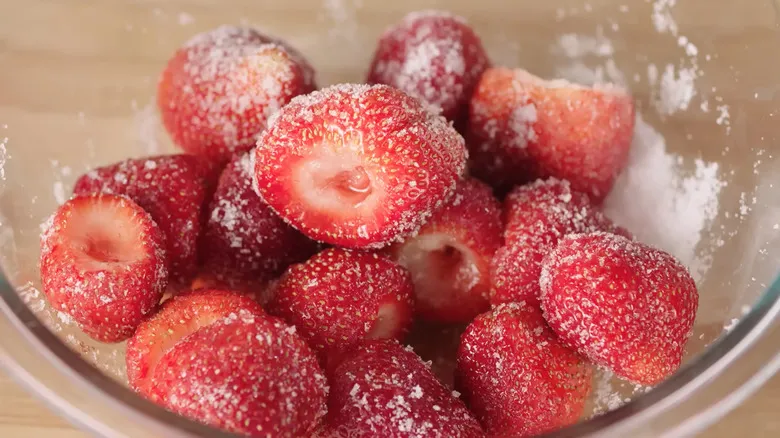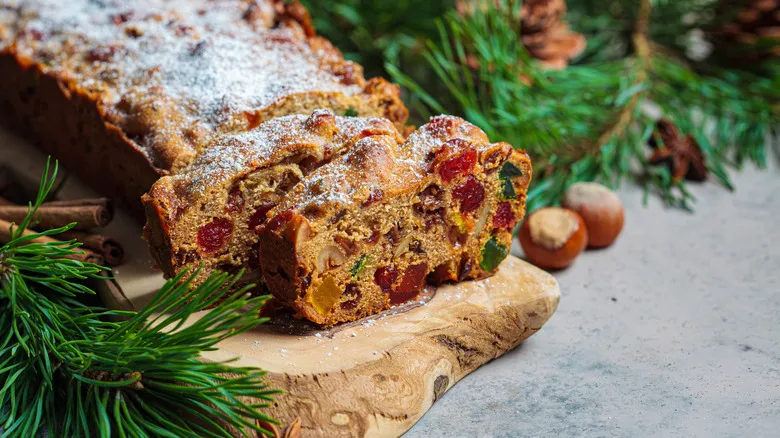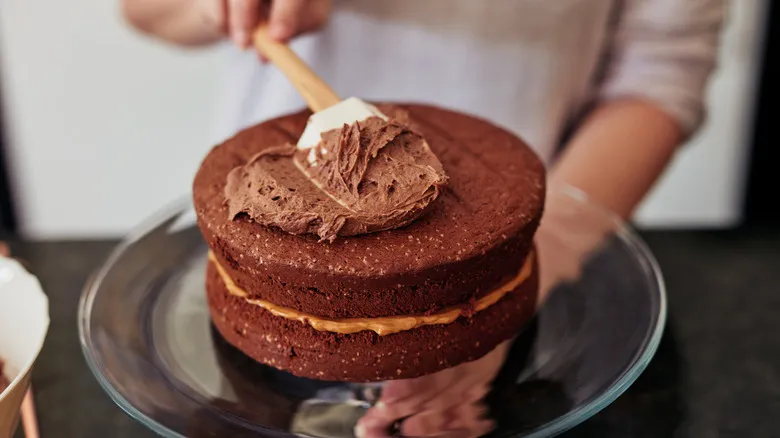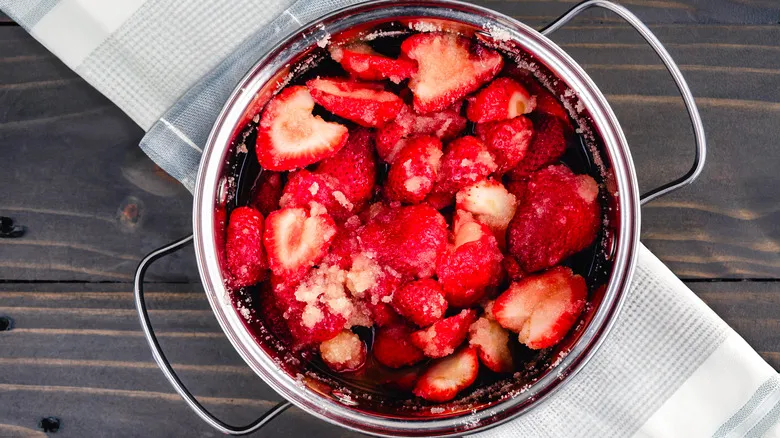How macerating berries in sugar works

The essential element of the macerating process is osmosis. To grasp this concept, it's important to familiarize ourselves with a few key terms. A semi-permeable membrane acts as a barrier between two regions, allowing certain substances to pass through while restricting others. A solution is formed when a solid, referred to as a solute, dissolves in a liquid, known as a solvent. Osmosis occurs when both sides of a semi-permeable membrane contain a solution with the same solute. The solvent will traverse the membrane until equilibrium is achieved, meaning that the concentration of solute to solvent is equal on both sides.
In the context of macerating berries, the cell walls of the berries function as our semi-permeable membrane. Berries are naturally rich in sugar, with their internal juice being a solution of sugar and water. When you sprinkle sugar on the outside of the berries, it combines with the water used to rinse them or the juice present on their surface. This mixture then interacts with the cell walls, causing the juice to seep out and blend with the sugar.
What makes this osmotic effect result in such delectable berries? The liquid extracted from the berries carries some of the fruit's flavor, which combines with the sugar to create a natural syrup that complements the berries beautifully. Furthermore, this process also allows some sugar to penetrate the semi-permeable membrane of the fruit, slightly breaking down the cell walls and resulting in a tender berry, even if they were initially firm and not fully ripe.
How macerating berries in liquid works

The liquid maceration process shares many scientific principles with the dry maceration technique. While osmosis remains a key factor, the solvent used is different. To wet macerate your berries, simply add a splash of your chosen liquid that contains either sugar or acid and allow the mixture to sit.
When using liquids that contain sugar, osmosis is still promoted. This includes options like liqueurs, wines, and sugar syrups such as maple syrup. The process may be slightly slower due to a lower sugar-to-solvent ratio on the outside, but the fundamental concept remains the same. In contrast, when using an acid-based solvent, the process changes because it involves more than just osmosis. For instance, the acid in balsamic vinegar breaks down the fruit's cell walls, enabling the juice to escape and blend with the vinegar. As a result, macerating berries with vinegar or lemon juice is quicker than using wine or syrup.
Best practices for macerating berries

For the best results when macerating berries, it's ideal to dry macerate them using plain granulated sugar. If you're looking to add some zest and expedite the process, consider mixing in a bit of lemon juice and zest. The acidity of the juice will help catalyze the maceration. Allow the berries to macerate for about 30 to 60 minutes, stirring and checking them regularly. You won’t need much sugar; approximately one cup is sufficient for around eight cups of berries.
If you prefer wet maceration, you can use an even lower liquid-to-berry ratio. The liquid will effectively coat the berries and produce a similar effect. Keep in mind that the type of liquid you choose will influence the flavor of the berries, but there are many excellent combinations that yield delicious results.
There's no need to chop the berries, even those with skins like blueberries or cherries. Osmosis will still occur. Leave smaller berries whole and only slice larger ones, such as strawberries, to your desired size for your dessert before macerating them (avoid cutting them after maceration). There's no requirement to apply heat during this process, as that would lead you toward making jam. Lastly, remember that this method works best with firmer, riper berries that can break down nicely. Steer clear of softer or overripe berries, as they can easily become mushy during maceration.
What to do with macerated berries

You have a bowl of your macerated berries, nestled in a delightful syrup. So, what can you do with these marinated fruits? The possibilities are truly limitless, and it's hard to make a mistake. The easiest option is simply to take a spoon and savor them. This is especially delightful if you've added some flavoring during the maceration. Sugar-macerated berries with lemon or other citrus fruits are a real treat, and for a slightly boozy twist, you can macerate them in orange liqueur or a triple sec like Cointreau or Drambuie.
Macerated berries are also fantastic when served with ice cream, atop yogurt, on crepes, or nestled in a simple tart crust. Once macerated, it's best to serve or refrigerate your berries right away, as the fruit will soften as the sugar solution reaches equilibrium. However, they can last in the fridge for up to 4 to 5 days and still taste quite good. For a quick and delicious way to use up leftover berries, consider pairing them with a batch of biscuits and a scoop of ice cream.
Recommended

Why Does Fruitcake Have Such A Bad Reputation?

The Secret To Rich, Bakery-Style Cookies Comes In A Box

Cut The Sweetness Of Store-Bought Frosting With An Easy Fix

Should You Thaw Frozen Berries Before Using Them In Baked Goods?
Next up

